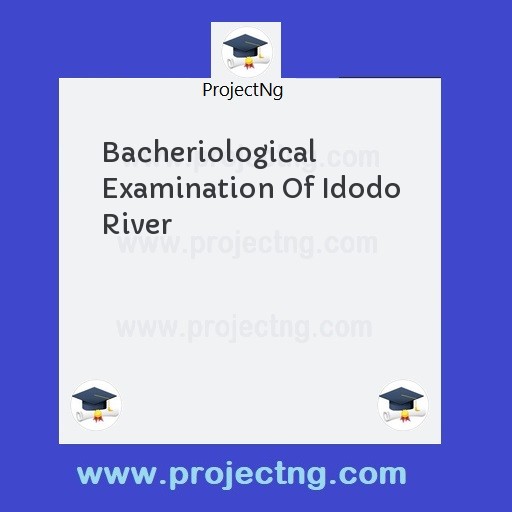Bacheriological Examination Of Idodo River
Science Lab Technology Project Topics
Get the Complete Project Materials Now! »
BACHERIOLOGICAL EXAMINATION OF IDODO RIVER
ABSTRACT
This work was aimed at assessing microbial coal of Idodo river in Enugu state Nigeria. The samples of river was obtained from the arc of low activity, and a place where human activities are very high. The samples were collected very early in the morning and afternoon. They were examined to determined the bacterial organisms that are pathogenic to man when they drink it from the samples were inoculated into media. Nutrient agar and macconkey agar media and incubate at the temperature range (350c - 370c). The following organisms were isolated. Streptococci faecalis clostridium Perfringens, Rhodococcis corphilus, Bifidobacteria, salmonella spp. The study shows that appropriate care should be taken to protect the river from being contaminated by these organisms. The quantity of pathogenic organisms collected were more in the afternoon.
TABLE OF CONTENTS
Title page
Certification
Dedication
Acknowledgement
Abstract
Table of contents
List of tables
CHAPTER ONE
INTRODUCTION
1.1 Background information
1.2 Aim and objectives of the study
1.3 Statement of problem
1.4 Hypothesis
1.5 Significance of the study
1.6 Limitation of the study
CHAPTER TWO
LITERATURE REVIEW
2.1 Microbial examination of contaminated water
2.2 Sources of river contamination
2.3 Standard uses of river
CHAPTER THREE
Materials and method
3.1 Materials
3.2 Sample collection
3.3 Analysis of sample collected sample inoculation and growth
CHAPTER FOUR
Results
4.1 Discussion
CHAPTER FIVE
Conclusion and recommendation
5.1 Conclusion
5.2 Recommendation
References
LIST OF TABLES
1. Sources of water contamination
2. Standard uses of river
3. Analysis of samples collected sampler inoculation and growth
4. Biochemical test
5. Isolated bacteria
CHAPTER ONE
INTRODUCTION
1.1 BACKGROUND INFORMATION
Natural water whether surface ground water, river, ocean or lakes contains variety of micro-organisms. The sanitary quality of drinking water is affected by both variety and number of micro-organisms. The sanitary quality of drinking water is affected by both Variety and number of micro-organisms available.
River is fit for drinking if its does not contain any micro-organism that are pathogenic to man. The WHO (1958) published the international standard for drinking water, in it water for consumption should be free from pathogenic organisms.
According to Howel (1994). He defined bacterial gience examination of river as the process of identification of bacteria organisms in the river. The bacteria organisms are pathogenic to man when they drink it. Some of the causative agents are singella dysenterae, vibro cholera, Salmonella Typhi, , Salmonella Paratyphi. Etc.
1.2 AIM AND OBJECTIVES OF THE STUDY
The aim of the study is to examine the micro-organisms in Idodo river. The specific objectives of the study are:
1. To identify the micro-organisms in the river.
2. To isolate the pathogenic organisms in the river.
1.3 STATEMENT OF PROBLEMS
The people that are using contaminated water are prone to different kinds of diseases. The diseases they suffered most are: dysentery, cholera, typhoid and paratyphoid. Etc. idodo river is likely to be contaminated at one time or the other due to human activities like washing, stooling, swimming etc.
Be the First to Share On Social

Enjoying our content?
Don't miss out on new videos! Subscribe to our YouTube channel for more awesome content.
Subscribe Now!













